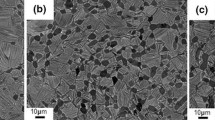Abstract
The kinetics of internal oxidation of silver-indium alloys containing 3.5, 5.9, and 9.8 at.% In in air at temperatures 773 to 973 K were established by TGA with no load applied to the specimens. Silver nodules free of oxide particles were observed to form at the surface during internal oxidation. The volume of these silver nodules was comparable to the total volume increase caused by internal oxidation. The alloys were also creep tested during oxidation in air at creep rates varying from 10−7 to 5×10−5 s−1 at 773, 873, and 973 K. The parabolic rate constants kp for the internal oxidation of the solute were determined from the measured widths of the internal oxidation zones. A small increase in kp was observed with increased strain rate. The large volume change associated with internal oxide formation resulted in a stress gradient between the stress-free surface and the internal oxidation front which is under a high compressive stress. Stress relief occurred by transport of silver to the surface. A Nabarro-Herring creep type mechanism based on lattice diffusion of Ag cannot account for the high rate of silver transport to the surface. Pipe-diffusion controlled creep is proposed as the mechanism of stress accommodation by silver diffusion.
Similar content being viewed by others
References
J. R. Mackert, Jr., R. D. Ringle, and C. W. Fairhurst,J. Dental Res. 62, 1229–1234 (1983).
T. A. Parthasarathy, Ph.D Thesis, Ohio State University (1983).
R. A. Rapp,Corr. 21, 382–400 (1965).
J. E. Verfurth and R. A. Rapp,Trans. AIME 230, 1310–1313 (1964).
F. H. Stott, Y. Ishida, D. P. Whittle, G. C. Wood, and B. D. Bastow,Oxid. Met. 18, 127–145 (1982).
Y. Ishida, F. H. Stott, B. D. Bastow, D. P. Whittle, and G. C. Wood,Oxid. Met. 18, 93–113 (1982).
G. C. Wood, F. H. Scott, D. P. Whittle, Y. Ishida, and B. D. Bastow,Corr. Sci. 23, 9–25 (1983).
H. J. Frost and M. F. Ashby, inDeformation Mechanism Maps (Pergamon Press, New York, 1983), pp. 20–25.
S. M. Park, Masters Thesis, Ohio State University (1985).
W. Eichenauer and G. Muller,Z. Metallk. 53, 321 and 700 (1962).
R. A. Rapp, D. F. Frank, and J. V. Armitage,Acta Met. 12, 505–513 (1964).
J. Weertman,J. Appl. Phys. 28, 362 (1957).
F. A. McClintock and A. S. Argon,Mechanical Behavior of Materials (Addison-Wesley, Reading, MA, 1966), p. 453.
U. F. Kocks, A. S. Argon, and M. F. Ashby,Prog. Mater. Sci. 19, 39 (1975).
J. P. Hirth and J. Lothe,Theory of Dislocations (McGraw-Hill, New York, 1982), p. 837.
F. R. N. Nabarro,Proc. Roy. Soc. (London),A175, 519 (1940).
Author information
Authors and Affiliations
Rights and permissions
About this article
Cite this article
Guruswamy, S., Park, S.M., Hirth, J.P. et al. Internal oxidation of Ag-in alloys: Stress relief and the influence of imposed strain. Oxid Met 26, 77–100 (1986). https://doi.org/10.1007/BF00664274
Received:
Issue Date:
DOI: https://doi.org/10.1007/BF00664274




